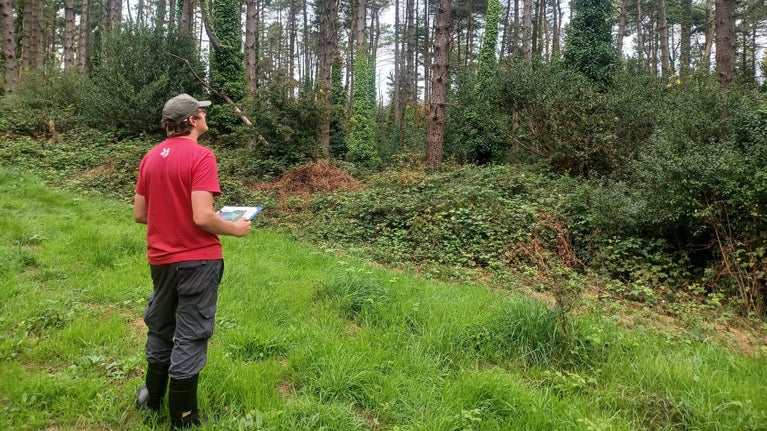Langdon Woods: adapting to a changing climate
- Published:
- 26 August 2024

Climate change threatens the landscapes and buildings we care for. Wildfires, heavy rain, more humidity, stronger winds, droughts, the loss of species and sea level changes – they all cause damage to places that the National Trust was set up to protect forever.
Making Langdon Hill Wood more resilient
Woods that are made up of many different trees, some young and some old, will cope better with a changing climate. If there’s a variety of different trees, then they won’t all be affected by the same tree diseases. Having trees of different ages means the wood as a whole will be better able to stand extremes of weather.
The health and wellbeing of woodlands relies on effective management to maintain a diverse environment in relation to species diversity, age and structure.
At the moment, the trees in Langdon Hill Wood on the Golden Cap Estate are largely the same age and there isn’t much variety of species – the trees are mostly Scot’s Pine, Beech and Japanese Larch. This puts Langdon Hill wood at much greater risk from the effects of climate change. Developing a natural woodland with an uneven age structure and a mixture of tree species will help the traditional flora and fauna in the woodlands to thrive.
The plan to help Langdon Wood become more resilient to climate change includes removing some trees and replanting areas with different types of tree species. This will also make sure there’s a variety of younger trees growing up to become the next generation of woodland.
Developing a natural woodland with an uneven age structure and a mixture of tree species will support the existing woodland flora and fauna to thrive adapt.
Choosing the right trees
What tree species will survive in a 2050, or 2080 climate?
To make the most significant gains in locking up atmospheric carbon, planted trees need to survive to maturity and beyond.
In line with predictions by the Forestry Commission, a broad range of native and conifer trees, which offer the best chances of thriving in those future climates, have been chosen for replanting the clearings left from the tree removal. All the trees planted at Langdon Wood will be grown from seed in the UK, peat free, by nurseries that have very high standards of biosecurity and provenance control.
Looking after woodlands
Our primary objective for the woodlands in our care is that they deliver more for nature and people. Actively managing woodland in places such as Langdon Hill, will significantly increase the potential for them to store carbon as part of wider work towards net zero carbon emissions.
Trees are the best natural solution to lock up the carbon in the air. They are unique in offering a huge range of environmental benefits, whilst growing timber that can be used to substitute carbon heavy materials such as steel and coal. The harvested wood will be put to good use – some used as material in the building industry, while others will provide biofuel for renewable energy projects. All income generated from the sale of timber goes directly to help us carry out our important conservation work.
Ultimately through our continued care we aim to create woodland which is more resilient to future environmental changes. This work will safeguard Langdon Wood to provide a space for nature and people in the future.
Our environmental pledges
- We're planting and establishing 20 million trees by 2030
- By 2030 we'll be carbon net-zero across our own emissions and those created by our supply chain, our tenanted land and buildings, and investments
- By 2025 we'll have created and restored 25,000 hectares of new wildlife habitats
- We'll create green corridors for people and nature near towns and cities